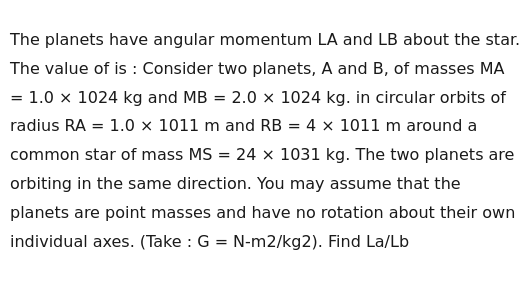Question
Question: The planets have angular momentum LA and LB about the star. The value of is : Consider two planets,...
The planets have angular momentum LA and LB about the star. The value of is : Consider two planets, A and B, of masses MA = 1.0 × 1024 kg and MB = 2.0 × 1024 kg. in circular orbits of radius RA = 1.0 × 1011 m and RB = 4 × 1011 m around a common star of mass MS = 24 × 1031 kg. The two planets are orbiting in the same direction. You may assume that the planets are point masses and have no rotation about their own individual axes. (Take : G = N-m2/kg2). Find La/Lb

1/4
Solution
The angular momentum of a point mass in a circular orbit about the center is given by L=mvr, where m is the mass of the object, v is its speed, and r is the radius of the orbit.
For a planet in a circular orbit around a star of mass MS, the gravitational force provides the centripetal force:
r2GMSm=rmv2
Solving for the speed v:
v2=rGMS
v=rGMS
Substitute this expression for v into the angular momentum formula:
L=m(rGMS)r
L=mrGMSr2
L=mGMSr
For planet A, the angular momentum LA is:
LA=MAGMSRA
For planet B, the angular momentum LB is:
LB=MBGMSRB
We need to find the ratio LBLA:
LBLA=MBGMSRBMAGMSRA
LBLA=MBMAGMSRBGMSRA
Since G and MS are constants for both planets, they cancel out in the ratio:
LBLA=MBMARBRA
Now, substitute the given values:
MA=1.0×1024 kg MB=2.0×1024 kg RA=1.0×1011 m RB=4.0×1011 m
LBLA=2.0×10241.0×10244.0×10111.0×1011
LBLA=2141
LBLA=21×41
LBLA=21×21
LBLA=41
Explanation:
The angular momentum of a planet in a circular orbit is L=mvr. The orbital speed v is determined by the balance of gravitational and centripetal forces, v=GMS/r. Substituting v into the expression for L gives L=mGMSr. The ratio of angular momenta is then LBLA=MBGMSRBMAGMSRA=MBMARBRA. Substituting the given values for masses and radii yields the ratio 2141=21×21=41.
